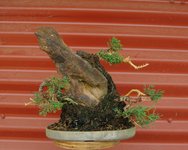Bonsai rock plantings, where the entire root system is confined ON the rock structure, shouldn't be confused with root over rock plantings, where the roots of the tree grow on and adhere to the rock surface before eventually entering a pot with bonsai soil. Muck is generally used for the former planting. It can be used to build a perimeter wall to hold regular soil, perhaps on a slab, but with many slab and rock plantings, it comprises 100% of the existing soil for the planting, and the roots happily colonize it and live in it for many years. There are several different recipes for muck, but sphagnum moss and clay seem to be the most important ingredients. The combination seems to create a medium that both retains it's form and doesn't wash away, holds moisture but drains well. Ultimately, these plantings tend to dry out more quickly then plantings in ceramic containers. Here is a Hinoki Cypress muck slab planting at the Smith Gilbert Gardens in Kennesaw GA... 25 + years old when the pic was taken, never re-potted and looking great.
View attachment 421662



